
© » KADIST
Wadada Leo Smith
Drawing & Print (Drawing & Print)
Kosmic Music is a musical score comprised of two parts: a single mixed media drawing titled Colors and Satellites, and a pair of mixed media drawings titled Koral Reef . Conceived of together as a single musical score, the three drawings exemplify a specific stage in the evolution of Wadada Leo Smith’s Ankhrasmation Language, which he has been developing since 1967. Although at first glance the works in Kosmic Music might appear abstract compositions drawn on paper, as with other scores produced by Smith, suggestions of musical structures are revealed upon closer inspection: an entanglement of musical sheets and bright geometric forms.
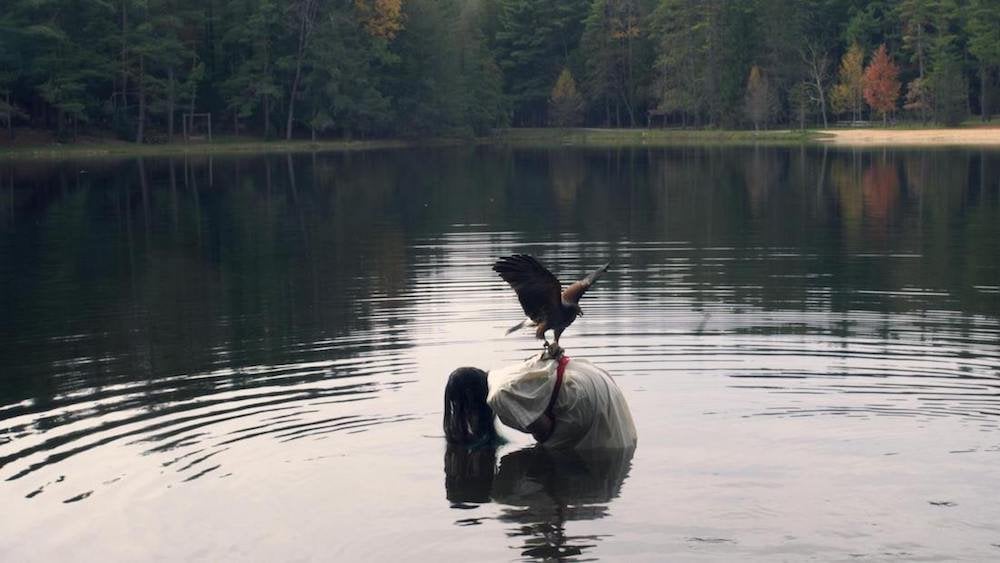
© » KADIST
Alicia Smith
The title of Alicia Smith’s video work, Teomama , means “God Carrier” in the Aztec language of Nahuatl. It was the name given to medicine men and women who carried the bones of Huitzilopochtli—the god of war, sun, and human sacrifice in ancient Mexico, and the national deity of the Aztecs. Of the many legends featuring Huitzilopochtli, the origin story of Tenochtitlan (present day Mexico City) is perhaps one of the most well-known.

© » KADIST
Alexis Smith
Iron Sorrows (1990) brings together what are for Alexis Smith common motifs and materials such as scavenged and repurposed metal, and street signage. Iron is one of nature’s most abundant metals. Smith, a philosopher of human detritus and poetic associations, presents it in this work as simultaneously everywhere yet paradoxically forgotten, lost in the heaps of refuse that fill junkyards and vacant lots.
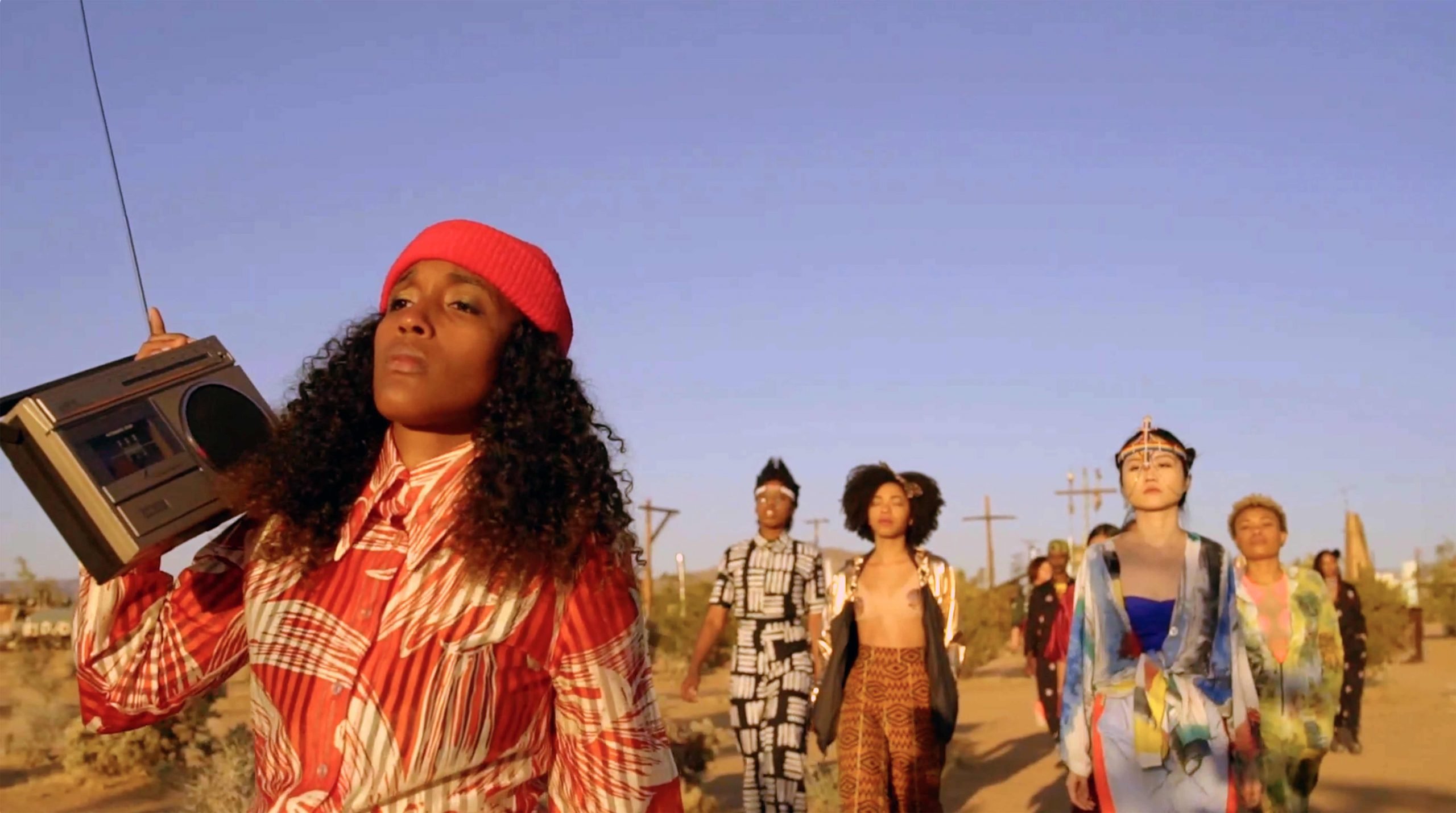
© » KADIST
Cauleen Smith
Set to the iconic and spiritual music of Alice Coltrane’s Turiyasangitananda (1937–2007), Cauleen Smith’s film Sojourner travels across the US to visit a series of sites important to an alternative and creative narrative of black history. While the approach may appear spiritual, it is more futuristic (Afrofuturism and Radical Jazz) than religious. Smith is interested in using the individual stories of “those who have formed their own solutions” as a reconstructive and healing lens for considering the past.
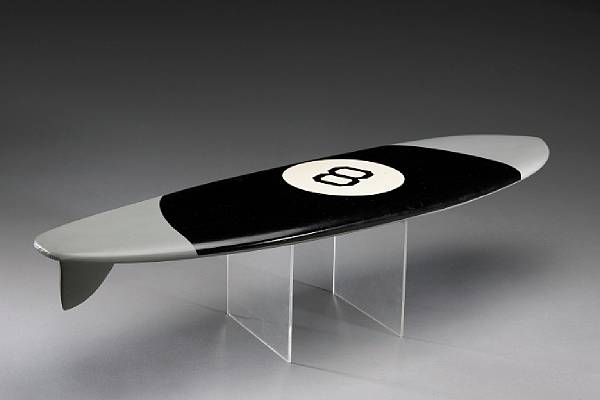
© » KADIST
Alexis Smith
In 8 Ball Surfboard (1995),Alexis Smith combines her long-term interests in California culture and conceptual assemblage. The surfboard, an emblem of Southern California, emblazoned with the image of an eight-ball, references numerous tropes and clichés of American popular culture, specifically subcultures related to pool halls, surfing, and beaches. Indeed, this model-scale surfboard may be a future pop-culture relic, referencing a particular surfer or era of board design.
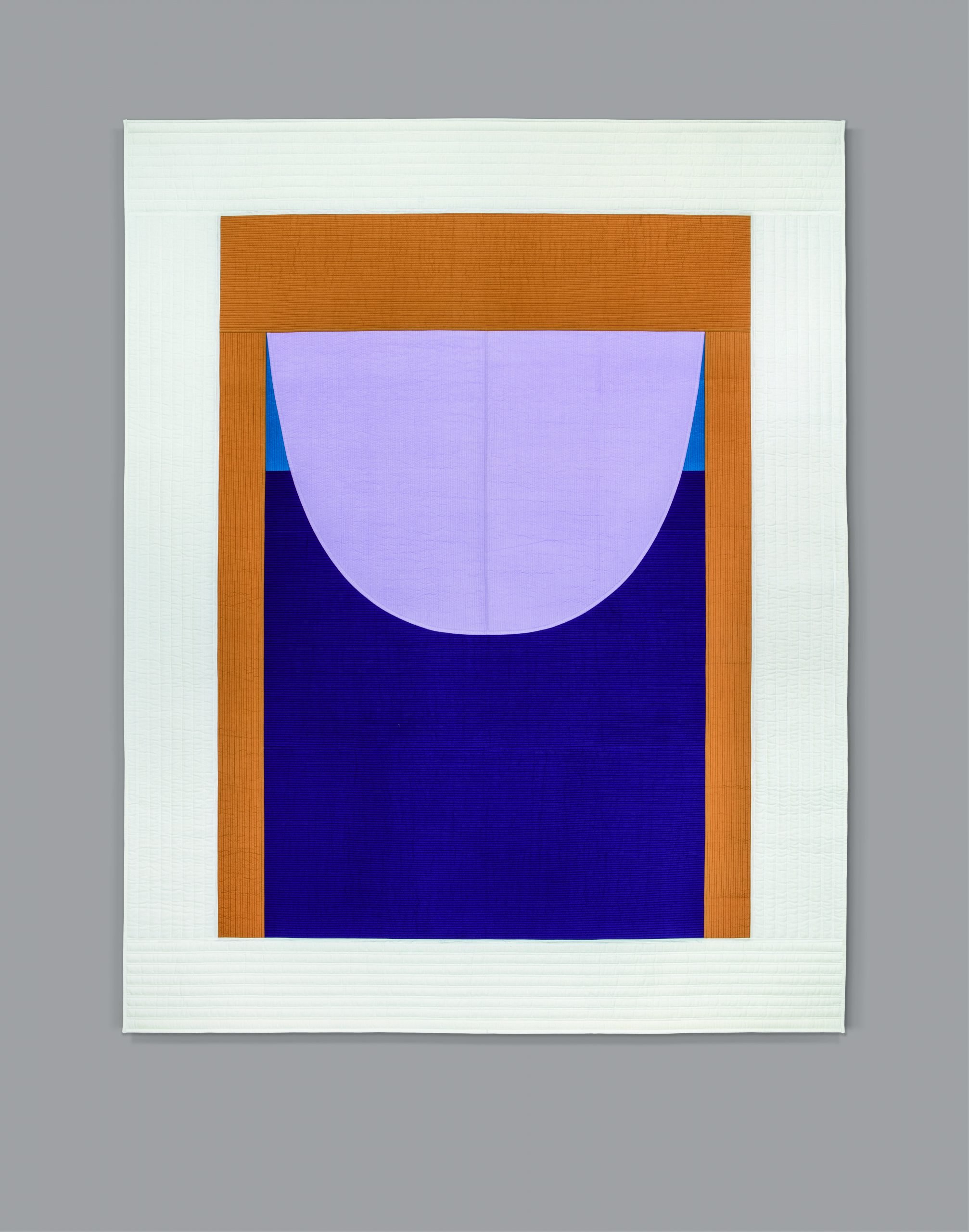
© » KADIST
Seulgi Lee
The Korean title for U: Repair the cowshed after losing the cow = Too late is —a famous Korean proverb meaning “you are doing something when you are already late to do it”. This work by Seulgi Lee is a nubi (traditional Korean quilt) blanket project that shows Korean proverbs expressed as geometric shapes. Nubi blankets were used as single sheet summer blankets in Korean households until the 1980s.

© » KADIST
Sable Elyse Smith
Sable Elyse Smith’s Pivot III resembles playground equipment uselessly reconfigured. The stainless-steel asterisks, assembled from prison visitation-room seating, are painted 2K black and blue: colors evoking the US criminal justice system, its racist enforcement, and the heavy-duty finish of finance capitalism with which the culture industry is enmeshed. The work consists of six long rods, affixed via plate to each of the faces of a central cube, from which they radiate in perfect symmetry.

© » KADIST
Gan Chin Lee
Drawing & Print (Drawing & Print)
In Studies of Chinese New Villages II Gan Chin Lee’s realism appears in the format of a fieldwork notebook; capturing present-day surroundings while unpacking their historical memory. The watercolor images on each note paper document the artist’s visits to various Chinese ‘New Villages’ in Malaysia. The studies, some in color and others in grey-scale, from this series include architectural ruins, portraits of people and animals, and groups of people in protest.

© » KADIST
Gan Chin Lee
Drawing & Print (Drawing & Print)
In Studies of Chinese New Villages II Gan Chin Lee’s realism appears in the format of a fieldwork notebook; capturing present-day surroundings while unpacking their historical memory. The watercolor images on each note paper document the artist’s visits to various Chinese ‘New Villages’ in Malaysia. The studies, some in color and others in grey-scale, from this series include architectural ruins, portraits of people and animals, and groups of people in protest.

© » KADIST
Gan Chin Lee
Drawing & Print (Drawing & Print)
In Studies of Chinese New Villages II Gan Chin Lee’s realism appears in the format of a fieldwork notebook; capturing present-day surroundings while unpacking their historical memory. The watercolor images on each note paper document the artist’s visits to various Chinese ‘New Villages’ in Malaysia. The studies, some in color and others in grey-scale, from this series include architectural ruins, portraits of people and animals, and groups of people in protest.

© » KADIST
Gan Chin Lee
Drawing & Print (Drawing & Print)
In Studies of Chinese New Villages II Gan Chin Lee’s realism appears in the format of a fieldwork notebook; capturing present-day surroundings while unpacking their historical memory. The watercolor images on each note paper document the artist’s visits to various Chinese ‘New Villages’ in Malaysia. The studies, some in color and others in grey-scale, from this series include architectural ruins, portraits of people and animals, and groups of people in protest.
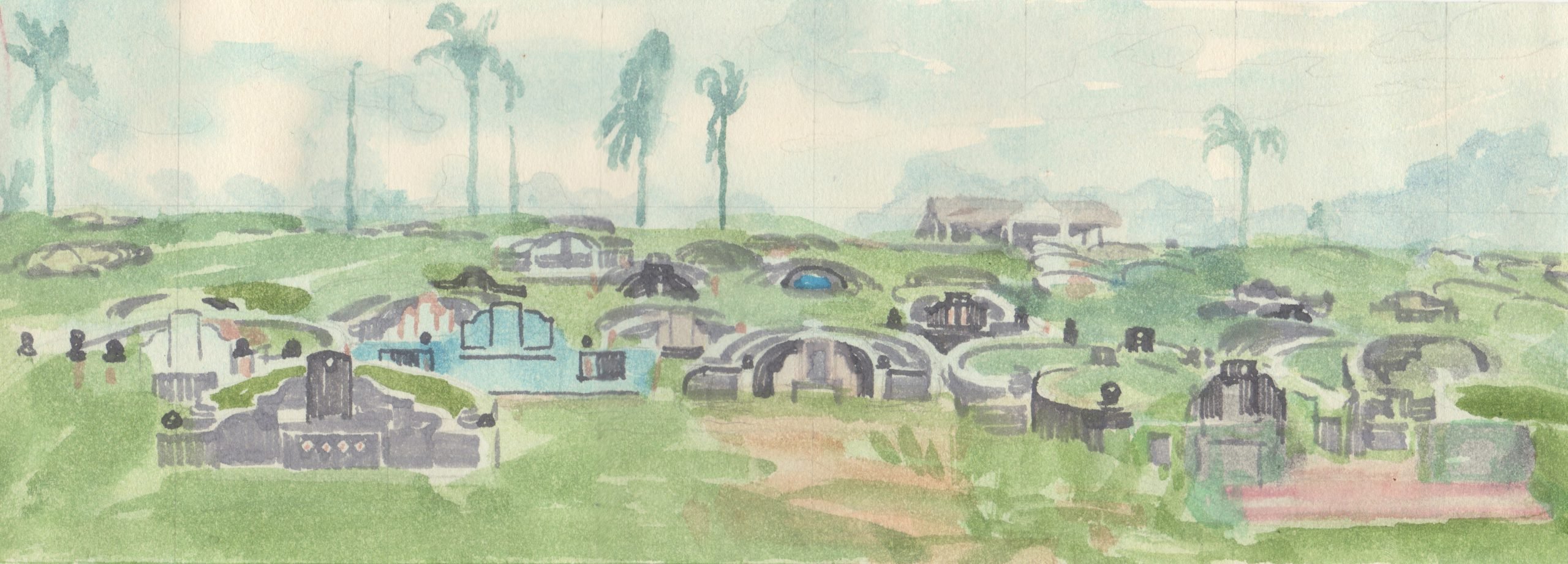
© » KADIST
Gan Chin Lee
Drawing & Print (Drawing & Print)
In Studies of Chinese New Villages II Gan Chin Lee’s realism appears in the format of a fieldwork notebook; capturing present-day surroundings while unpacking their historical memory. The watercolor images on each note paper document the artist’s visits to various Chinese ‘New Villages’ in Malaysia. The studies, some in color and others in grey-scale, from this series include architectural ruins, portraits of people and animals, and groups of people in protest.

© » KADIST
Gan Chin Lee
Drawing & Print (Drawing & Print)
In Studies of Chinese New Villages II Gan Chin Lee’s realism appears in the format of a fieldwork notebook; capturing present-day surroundings while unpacking their historical memory. The watercolor images on each note paper document the artist’s visits to various Chinese ‘New Villages’ in Malaysia. The studies, some in color and others in grey-scale, from this series include architectural ruins, portraits of people and animals, and groups of people in protest.

© » KADIST
Gan Chin Lee
Drawing & Print (Drawing & Print)
In Studies of Chinese New Villages II Gan Chin Lee’s realism appears in the format of a fieldwork notebook; capturing present-day surroundings while unpacking their historical memory. The watercolor images on each note paper document the artist’s visits to various Chinese ‘New Villages’ in Malaysia. The studies, some in color and others in grey-scale, from this series include architectural ruins, portraits of people and animals, and groups of people in protest.

© » KADIST
Tim Lee
Part of Tim Lee’s practice involves envisioning himself reenacting key moments from iconic peoples’ lives. In the photograph Untitled (Stanley Kubrick, 1945) (2010), Lee re-creates a self-portrait by Stanley Kubrick from 1945. Kubrick shot the original photograph in the mirror when he was just beginning his career as a photojournalist.

© » KADIST
Lee Kit
The work Tender is composed of several elements: a porcelain spoon, a florescent lamp box, a small portable night light, a shelf with nearly invisible embossments of flowers and a jar of jam resting on a black plastic tray. The cardboard painting is made of acrylic and inkjet ink on which we can read Tender . Tender is a brand of extra soft tissue paper, it refers to an intimate comfort but results in a sentiment of melancholy and absence.

© » KADIST
Dinh Q. Lê
Hill of Poisonous Trees (three men) (2008) exemplifies the artist’s signature photo-weaving technique, in which he collects diverse found photographs—portraits of anonymous people, stills from blockbuster films, or journalistic images—cuts them into strips, and weaves them into new composition. The title of the series is translated from the Khmer phrase Tuol Sleng , which literally means a poisonous hill or a place on a mound to keep those who bear or supply guilt, and the photographs came from the Tuol Sleng Genocide Museum in Cambodia, a former prison where at least 200,000 Cambodians were executed during the reign of the Khmer Rouge between 1975 and 1979. In this particular image, three men stand against the backdrop of what looks like a prison interior.

© » KADIST
Shu Lea Cheang
Reflecting upon the transformation of surveillance techniques since the panopticon to include contemporary 3-D facial recognition, AI, and the Internet, Shu Lea Cheang’s 3x3x6 – 10 cases 10 data restages the rooms of the Palazzo delle Prigioni—a Venetian prison from the sixteenth century in operation until 1922—as a high-tech surveillance space. Taking as its starting point the story of libertine writer Giacomo Casanova, imprisoned in the Prigioni in 1755, Cheang has conducted in-depth studies on ten historical and contemporary cases of subjects incarcerated because of gender or sexual dissent, including the Marquis de Sade and Michel Foucault, as well as contemporary cases from Taiwan and South Africa. Their fictionalized portraits become part of the exhibition’s system; the title of which refers to today’s standardized architecture of industrial imprisonment: a 3 x 3 square-metre cell constantly monitored by 6 cameras.

© » KADIST
Gan Chin Lee
Drawing & Print (Drawing & Print)
In Studies of Chinese New Villages II Gan Chin Lee’s realism appears in the format of a fieldwork notebook; capturing present-day surroundings while unpacking their historical memory. The watercolor images on each note paper document the artist’s visits to various Chinese ‘New Villages’ in Malaysia. The studies, some in color and others in grey-scale, from this series include architectural ruins, portraits of people and animals, and groups of people in protest.

© » KADIST
Gan Chin Lee
Drawing & Print (Drawing & Print)
In Studies of Chinese New Villages II Gan Chin Lee’s realism appears in the format of a fieldwork notebook; capturing present-day surroundings while unpacking their historical memory. The watercolor images on each note paper document the artist’s visits to various Chinese ‘New Villages’ in Malaysia. The studies, some in color and others in grey-scale, from this series include architectural ruins, portraits of people and animals, and groups of people in protest.

© » KADIST
Gan Chin Lee
Drawing & Print (Drawing & Print)
In Studies of Chinese New Villages II Gan Chin Lee’s realism appears in the format of a fieldwork notebook; capturing present-day surroundings while unpacking their historical memory. The watercolor images on each note paper document the artist’s visits to various Chinese ‘New Villages’ in Malaysia. The studies, some in color and others in grey-scale, from this series include architectural ruins, portraits of people and animals, and groups of people in protest.

© » KADIST
Gan Chin Lee
Drawing & Print (Drawing & Print)
In Studies of Chinese New Villages II Gan Chin Lee’s realism appears in the format of a fieldwork notebook; capturing present-day surroundings while unpacking their historical memory. The watercolor images on each note paper document the artist’s visits to various Chinese ‘New Villages’ in Malaysia. The studies, some in color and others in grey-scale, from this series include architectural ruins, portraits of people and animals, and groups of people in protest.

© » KADIST
Jorge de León
Jorge de León most well-known work was a radical gesture, and one of his earliest artworks: in his 2000 performance, The Circle, de León sewed his own mouth closed as a protest against the silencing of citizens in the face of social corruption. His Cristal series is more demure, but follows a similar theme. In these works, delicate, web-like lines emerge against dark backgrounds, creating orbs of negative space, pitch black.

© » KADIST
Gan Chin Lee
Drawing & Print (Drawing & Print)
In Studies of Chinese New Villages II Gan Chin Lee’s realism appears in the format of a fieldwork notebook; capturing present-day surroundings while unpacking their historical memory. The watercolor images on each note paper document the artist’s visits to various Chinese ‘New Villages’ in Malaysia. The studies, some in color and others in grey-scale, from this series include architectural ruins, portraits of people and animals, and groups of people in protest.

© » KADIST
An-My LE
The print Patient Admission, US Naval Hospital Ship Mercy, Vietnam (2010) features an Asian Buddhist monk and an American Navy Solider on board the Mercy ship –one of the two dedicated hospital ships of the United States Navy– sitting upright in their chairs and adopting the same posture. In the background, the steel pillars creates a division of space implying a separation the two men according to their geographic regions of origin or residence, their vocations, their ethnicities, and their attitudes toward war. Yet, the mirrored body language of the two characters also suggests their reconciliation into a dialogue perhaps characterized by the protagonists’ physical and spiritual conversation.
Gan Chin Lee
Gan Chin Lee is a Malaysian artist of Chinese descent known across Southeast Asia for his realist paintings that painstakingly register the ethnic and religious complexities of Malaysia...
An-My LE
- location: New York, New York
- year born: 1960
- gender: female
- home town: Saigon, Vietnam
Alexis Smith
- location: Los Angeles, California
- year born: 1949
- gender: female
- nationality: American
- home town: Los Angeles, California
Tim Lee
- location: Vancouver, Canada
- year born: 1975
- gender: male
- nationality: Korean
- home town: Seoul, South Korea
Seulgi Lee
Seulgi Lee’s artistic references range from anthropological materials, archetypical linguistic elements, vernacular culture, handcrafts tradition, to the graphic culture of animistic belief found in diverse locals around the world...
Shu Lea Cheang
Shu Lea Cheang’s practice combines artistic concerns with social issues, and is highly acclaimed as a leading figure in post-porn feminist art, becoming a crucial player that resonates with present-day subjects of queerness and trans discourse...
Cauleen Smith
Cauleen Smith is an artist and filmmaker whose approach has been shaped by the discourse of mid-twentieth-century experimental film — including structuralism, third world cinema, and science fiction...
Wadada Leo Smith
Wadada Leo Smith is an avant-garde jazz musician, composer, educator and visual artist, celebrated for his creative and unconventional approach to music...
Alicia Smith
Alicia Smith is a Xicana artist and activist whose work thoughtfully engages with the subjects of indigeneity, colonialism, the environment, and the female body...
Lee Kit
Born in 1978 in Hong Kong Lives and works in Taipei, Taiwan Lee Kit represented the Honk Kong pavilion at the Venice Biennale in 2013 where the exhibition was turned into a half functional private space...
Sable Elyse Smith
Sable Elyse Smith is an interdisciplinary artist, writer, and educator based in New York and Richmond, Virginia...

© » APERTURE
about 5 months ago (12/01/2023)
For the past two decades, An-My Lê has used photography to examine her personal history and the legacies of US military power, probing the tension between experience and storytelling....
-
1990-1999
Alexis Smith
1990Iron Sorrows (1990) brings together what are for Alexis Smith common motifs and materials such as scavenged and repurposed metal, and street signage...
Alexis Smith
1995In 8 Ball Surfboard (1995),Alexis Smith combines her long-term interests in California culture and conceptual assemblage...
-
2000-2009
Dinh Q. Lê
2008Hill of Poisonous Trees (three men) (2008) exemplifies the artist’s signature photo-weaving technique, in which he collects diverse found photographs—portraits of anonymous people, stills from blockbuster films, or journalistic images—cuts them into strips, and weaves them into new composition...
-
2010-2019
An-My LE
2010The print Patient Admission, US Naval Hospital Ship Mercy, Vietnam (2010) features an Asian Buddhist monk and an American Navy Solider on board the Mercy ship –one of the two dedicated hospital ships of the United States Navy– sitting upright in their chairs and adopting the same posture...
Jorge de León
2015Jorge de León most well-known work was a radical gesture, and one of his earliest artworks: in his 2000 performance, The Circle, de León sewed his own mouth closed as a protest against the silencing of citizens in the face of social corruption...
Alicia Smith
2018The title of Alicia Smith’s video work, Teomama , means “God Carrier” in the Aztec language of Nahuatl...
Cauleen Smith
2018Set to the iconic and spiritual music of Alice Coltrane’s Turiyasangitananda (1937–2007), Cauleen Smith’s film Sojourner travels across the US to visit a series of sites important to an alternative and creative narrative of black history...
Seulgi Lee
2018The Korean title for U: Repair the cowshed after losing the cow = Too late is —a famous Korean proverb meaning “you are doing something when you are already late to do it”...
Gan Chin Lee
Drawing & Print
2019(Drawing & Print) In Studies of Chinese New Villages II Gan Chin Lee’s realism appears in the format of a fieldwork notebook; capturing present-day surroundings while unpacking their historical memory...
Gan Chin Lee
Drawing & Print
2019(Drawing & Print) In Studies of Chinese New Villages II Gan Chin Lee’s realism appears in the format of a fieldwork notebook; capturing present-day surroundings while unpacking their historical memory...
Gan Chin Lee
Drawing & Print
2019(Drawing & Print) In Studies of Chinese New Villages II Gan Chin Lee’s realism appears in the format of a fieldwork notebook; capturing present-day surroundings while unpacking their historical memory...
Gan Chin Lee
Drawing & Print
2019(Drawing & Print) In Studies of Chinese New Villages II Gan Chin Lee’s realism appears in the format of a fieldwork notebook; capturing present-day surroundings while unpacking their historical memory...
Gan Chin Lee
Drawing & Print
2019(Drawing & Print) In Studies of Chinese New Villages II Gan Chin Lee’s realism appears in the format of a fieldwork notebook; capturing present-day surroundings while unpacking their historical memory...
Gan Chin Lee
Drawing & Print
2019(Drawing & Print) In Studies of Chinese New Villages II Gan Chin Lee’s realism appears in the format of a fieldwork notebook; capturing present-day surroundings while unpacking their historical memory...
Shu Lea Cheang
2019Reflecting upon the transformation of surveillance techniques since the panopticon to include contemporary 3-D facial recognition, AI, and the Internet, Shu Lea Cheang’s 3x3x6 – 10 cases 10 data restages the rooms of the Palazzo delle Prigioni—a Venetian prison from the sixteenth century in operation until 1922—as a high-tech surveillance space...
Gan Chin Lee
Drawing & Print
2019(Drawing & Print) In Studies of Chinese New Villages II Gan Chin Lee’s realism appears in the format of a fieldwork notebook; capturing present-day surroundings while unpacking their historical memory...
Gan Chin Lee
Drawing & Print
2019(Drawing & Print) In Studies of Chinese New Villages II Gan Chin Lee’s realism appears in the format of a fieldwork notebook; capturing present-day surroundings while unpacking their historical memory...
Gan Chin Lee
Drawing & Print
2019(Drawing & Print) In Studies of Chinese New Villages II Gan Chin Lee’s realism appears in the format of a fieldwork notebook; capturing present-day surroundings while unpacking their historical memory...
Gan Chin Lee
Drawing & Print
2019(Drawing & Print) In Studies of Chinese New Villages II Gan Chin Lee’s realism appears in the format of a fieldwork notebook; capturing present-day surroundings while unpacking their historical memory...
Gan Chin Lee
Drawing & Print
2019(Drawing & Print) In Studies of Chinese New Villages II Gan Chin Lee’s realism appears in the format of a fieldwork notebook; capturing present-day surroundings while unpacking their historical memory...
-
2020-2029
Sable Elyse Smith
2020Sable Elyse Smith’s Pivot III resembles playground equipment uselessly reconfigured...
